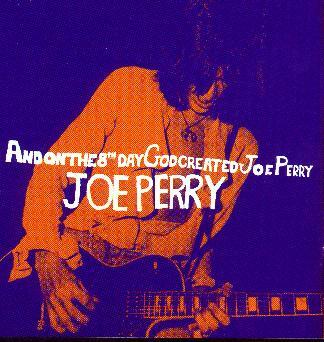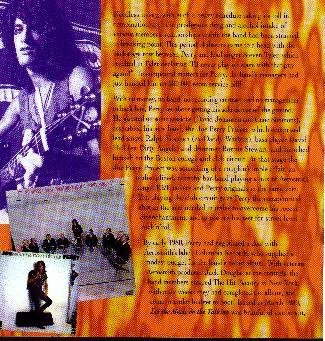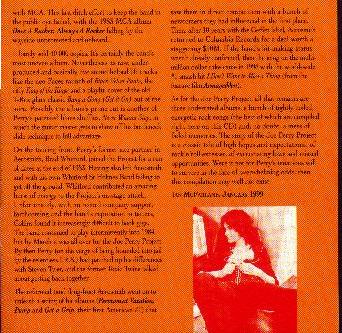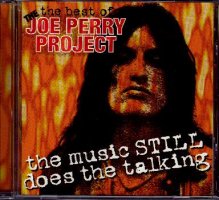The complete liner notes.
AND ON THE 8TH DAY GOD CREATED JOE PERRY
For guitarist Joe Perry, the thought of Launching a solo career was, by alternate degrees, an
exciting and daunting prospect. The time was October 1979, and Perry had just quit Aerosmith
after a decade on the road. The bandís bevy of rip snorting, high tensile, multi-platinum albums
(Aerosmith, Get Your Wings, Rocks, Toys In The Attic and Draw The Line) had established
Aerosmith as one the USAís major hard rock attractions, their pre-eminent position on the touring
circuit well confirmed.
For all that, 1979 had been a difficult year for Aerosmith. The much-delayed Night in
the Ruts album had cost over US$1M to produce (most of it spent on wasted studio
time). Although it reached US #14 when finally released in November 1979, it was the bandís least
successful album in five years. Perry only played guitar on five of the albumís tracks, with the likes
of Jimmy Crespo (his eventual replacement), Neil Thompson and Richie Supa contributing the
missing guitar parts. In between attempts at recording, the band had spent much of the year
touring heavily, working the US festival circuit alongside the likes of Ted Nugent, Cheap Trick and
Thin Lizzy.
Needless to say, with such a heavy schedule taking itís toll in combination with the prodigious drug
and alcohol intake of various members, relationships within the band had been strained to breaking
point. This period of dissent came to a head with the backstage row between Perry and lead singer
Steven Tyler, which resulted in Tyler declaring ďIíll never play on stage with that guy again!Ē. To
compound matters for Perry, the bandís managers had just handed him a $80,000 room service bill!
With no money, no band, no recording contract and no management to back him, Perry set about
getting his solo off the ground. He guested on some sessions (David Johansen and Gene Simmons),
assembled his new band, the Joe Perry Project, which comprised lead singer Ralph Mormon (ex-
Daddy Warbux), bass player David Hull (ex-Dirty Angels) and drummer Ronnie Stewart, and
launched himself on the Boston college and club circuit. At that stage the Joe Perry Project was
something of a rough Ďní tumble affair, an undisciplined, raunchy bar-band playing a mix of
Aerosmith song, R&B covers, and Perry originals in the same vein. Yet, playing the club circuit gave
Perry the metaphorical shot in the arm needed it order to overcome his recent disenchantment, and
to restore his zest for street-level rock Ďní roll.
By early 1980, Perry had negotiated a deal with Aerosmithís label, Columbia Records, who supplied a
modest budget for the bandís debut album. With veteran Aerosmith producer Jack Douglas at the
controls, the band members entered The Hit Factory in New York; within sex weeks they had
completed the album, and come in under budget to boot! Issued in March 1980, Let the
Music do the Talking was brimful of exuberant, swaggering funky rock Ďní roll. If
tracks like Let the Music do the Talking, Discount Dogs and Life at a
Glance echoed Aerosmithís brash, riff-heavy take on arena rock, they were all the more
exciting for their fluent dynamics and barley contained rock energy. As the bandís sole guitarist,
Perry also pulled out all the stops with his fiery licks on Conflict of Interest, Shooting
Star, the funky R&B stomper Rockiní Train and the whiplash
instrumental Break Song. The band issued Let the Music do the
Talking as a single, backed with the non-album cut Bone to Bone (an
instrumental retake of a song previously recorded by Aerosmith for Night in the
Ruts).
With moderate support from Columbia, and virtually no commercial airplay, the album managed to
peak at #47 on the US chart, selling a more-than-respectable 250,000 copies in the process. By
the stage the Joe Perry Project had hit the touring circuit across the USA. Unfortunately, with
his excessive alcohol intake getting the better of him, the volatile Ralph Morman proved
incompatible with the road. Notwithstanding his own legendary drug and alcohol abuse, Perry
sacked Morman and replaced him with the untried Joey Mala (ex-Revolver) for the rest of the year.
With the bandís touring commitments out of the way by December, Perry found a permanent
frontman in the shape of ex-balloon singer Charlie Farren. Farren was also an expert rhythm
guitarist and songwriter, which helped lighten the load on Perry all round. Tuned to perfection
after a year on the road, and primed to flashpoint by the arrival of Farren, the Joe Perry Project
was bursting at the seams to record Plantís mobile truck and producer/engineer Bruce Botnick, the
band cut Iíve Got the Rock Ďní Rolls Again inside the elegant but decrepit
Boston Opera House.
Despite its lowly chart placement of #100 (June 1981), the album remains the perfect synthesis of
the Projectís primal bar-band chops, arena rock aspirations and finely honed sense of rock Ďní roll
dynamics. Hull and Farren contributed a couple of blazing, yet accessible rockers apiece, including
Buzz Buzz (Hull) and East Coast, West Coast (Farren) which were
respectively lifted as the A and B-sides of the albumís single. Farren also co-wrote, with Perry, the
title track and the suitably named No Substitute for Arrogance. As for Perry, he
contributed two of his strongest compositions to that time in the bluesy Soldier of
Fortune, and the astonishingly agile South Station Blues which had
started out as a 30 second piece called Shit House Shuffle that Aerosmith used to loosen up with.
With the album failing to sell, and Perry falling deeper into debt, the only recourse was to go on the
road, which the band did for the rest of the year (supporting the likes of Heart, ZZ Top and J.
Geils Band). By early 1983, despite the rightness of the bandís playing. Farren, Hull, and Stewart
had all handing in their notice, leaving Perry to pick up the pieces. When things fell into place,
Perry described the new line-up (Cowboy Mach Bell on vocals, Danny Hargrove on bass and Joe Pet
on drums) as a bunch of ďyoung guys who donít give a shit, like wild men, fuckiní pirates. They just
get in the van and goĒ.
Naturally it comes as no surprise that, in a respect of the legendary Aerosmith penchant for one-
the-road excesses, the members of this Joe Perry Project are said to have gleefully abandoned all
notions of decency. If the breathless reports of the day to be believed, a roaring drunk Bell took
to periodically parading around in the nude, creating havoc. Meanwhile, Perry was not unfamiliar
with the Keith Richards state of rock Ďní roll revelry mode Ė pumped full of sufficient substances to
not always know what was going on around him. The bandís roadies also joined in the rabble-rousing
all of which combined to get the Project banned from a string of Holiday Inn and locked up in jail on
several occasions.
The stuff of which rock legends are made, to be sure, but no necessarily conductive to business
(even show business). Amongst all the road madness, the bandís tour manager, Tim Collins, managed
to secure the Project a new record deal with MCA. This last ditch effort to keep the band in the
public eye failed, with the 1983 MCA album Once A Rocker, Always A
Rocker falling by the wayside unpromoted and unheard.
It barely sold 40,000 copies. Itís certainly the bandís most uneven album. Nevertheless its raw,
under-produced and basically live sound helped lift tracks like the neo-faces raunch of Black
Velvet Pants, the riffy King of the Kings and a playful cover of the old
T-Rex glam classic Bang a Gong (Get it On) out of the mire. Possibly the albumís
prime cut is another of Perry patented blues shuffles, Never Wanna Stop, in which
the guitar gets to show off his bottleneck slide technique to full advantage.
On the touring front, Perryís former axe partner in Aerosmith, Brad Whitford, joined the project
for a run of dates at the end of 1983. Having also left Aerosmith, and with his own Whitford St.
Holmes Band failing to get off the ground. Whitford contributed an amazing burst of energy to
the Projectís on-stage attack. Unfortunately, with no record company support forthcoming and the
bandís reputation in tatters, Collins found it increasingly difficult to book gigs. The band continued
to play intermittently into 1984, but by March it was all over for the Joe Perry Project. By then
Perry (on the verge of being hounded into jail by the relentless I.R.S.) had patched up his
differences with Steven Tyler, and the former Toxic Twins talked about getting back together.
The reformed (and drug-free) Aerosmith went on to unleash a string of hit albums
(Permanent Vacation, Pump and Get A Grip, their first
American #1) that saw them in direct competition with a bunch of newcomers they had influenced
in the first place. Then, after 10 years with the Geffen label, Aerosmith returned to Columbia
Records for a deal worth a staggering $30M. If the bandís hit-making wasnít already confirmed,
then the icing on the cake came in 1998 with the world-wide #1 smash hit I Donít Want to
Miss a Thing (from the feature film Armageddon).
As for the Joe Perry Project, all that remains are three underrated albums, a bunch of tightly
coiled energetic rock songs (the best of which are compiled right here on this CD) and, no doubt, a
mess of faded memories. The story of the Joe Perry Project is a classic tail of high hopes and
expectations, of rock Ďní roll excesses, of excruciating lows and missed opportunities. Were it not
Perryís tenacious will to survive in the face of overwhelming odds, the this compilation may well no
exist.
IAN McFARLANE, JANUARY 1999

Pictures from the album.










Purchase Online

Buy The "The Best Of The Joe Perry Project - The Music STILL Does The Talking" CD From Amazon.com!


Crossfire's Rating

Crossfire's "The Best Of The Joe Perry Project - The Music STILL Does The Talking" Rating




Four Flames

If you want to find out what each number of flames mean what...Go to the Crossfire Ratings section!

Click here to go back to the Discography main page.
























